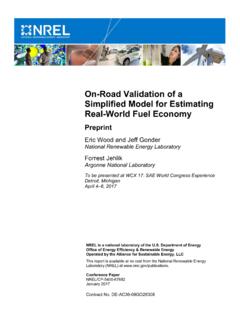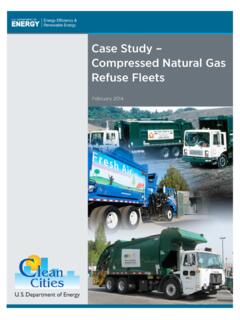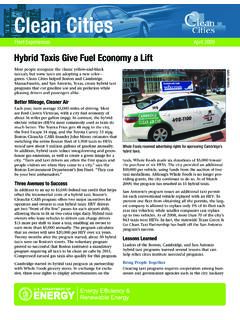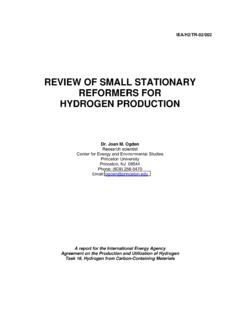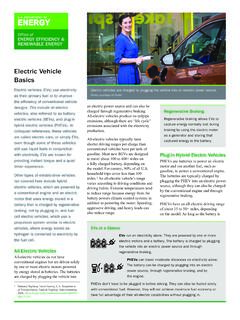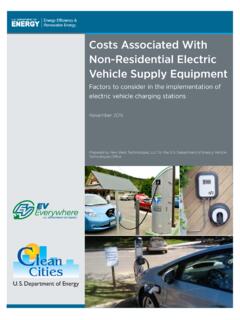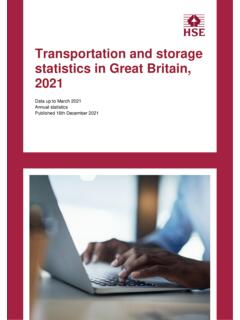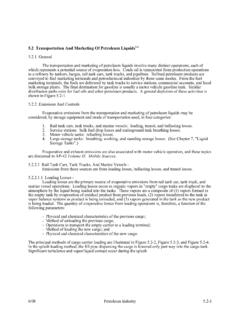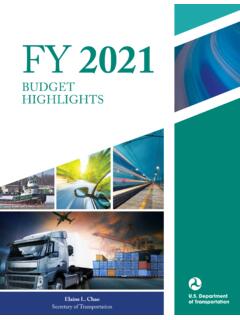Transcription of Energy and the Hydrogen Economy
1 Energy and the Hydrogen Economy Ulf Bossel Fuel Cell Consultant Morgenacherstrasse 2F CH-5452 Oberrohrdorf / Switzerland +41-56-496-7292 and Baldur Eliasson ABB Switzerland Ltd. Corporate Research CH-5405 Baden-D ttwil / Switzerland 1 Abstract Between production and use any commercial product is subject to the following processes: packaging, transportation , storage and transfer. The same is true for Hydrogen in a Hydrogen Economy . Hydrogen has to be packaged by compression or liquefaction, it has to be transported by surface vehicles or pipelines, it has to be stored and transferred. Generated by electrolysis or chemistry, the fuel gas has to go through theses market procedures before it can be used by the customer, even if it is produced locally at filling stations.
2 As there are no environmental or energetic advantages in producing Hydrogen from natural gas or other hydrocarbons, we do not consider this option, although Hydrogen can be chemically synthesized at relative low cost. In the past, Hydrogen production and Hydrogen use have been addressed by many, assuming that Hydrogen gas is just another gaseous Energy carrier and that it can be handled much like natural gas in today s Energy Economy . With this study we present an analysis of the Energy required to operate a pure Hydrogen Economy . High-grade electricity from renewable or nuclear sources is needed not only to generate Hydrogen , but also for all other essential steps of a Hydrogen Economy . But because of the molecular structure of Hydrogen , a Hydrogen infrastructure is much more Energy -intensive than a natural gas Economy .
3 In this study, the Energy consumed by each stage is related to the Energy content (higher heating value HHV) of the delivered Hydrogen itself. The analysis reveals that much more Energy is needed to operate a Hydrogen Economy than is consumed in today's Energy Economy . In fact, depending on the chosen route the input of electrical Energy to make, package, transport, store and transfer Hydrogen may easily double the Hydrogen Energy delivered to the end user. But precious Energy can be saved by packaging Hydrogen chemically in a synthetic liquid hydrocarbon like methanol or dimethylether DME. We therefore suggest modifying the vision of a Hydrogen Economy by considering not only the closed Hydrogen (water) cycle, but also the closed carbon (CO2) cycle.
4 This could create the intellectual platform for the conception of a post-fossil fuel Energy Economy based on synthetic hydrocarbons. Carbon atoms from biomass, organic waste materials or recycled carbon dioxide could become the carriers for Hydrogen atoms. Furthermore, the Energy consuming electrolysis may be partially replaced by the less Energy intensive chemical transformation of water and carbon to synthetic hydrocarbons. As long as the carbon comes from the biosphere ("biocarbon") the synthetic hydrocarbon Economy would be as benign with respect to environment as a pure Hydrogen Economy . But the use of "geocarbons" from fossil sources should be avoided to uncouple Energy use from global worming. 2 Table of Contents 1. Introduction 3 2.
5 Properties of Hydrogen 4 3. Energy Needs of a Hydrogen Economy 6 4. Production of Hydrogen 7 Electrolysis 7 Reforming 9 5. Packaging of Hydrogen 10 Compression of Hydrogen 10 Liquefaction of Hydrogen 12 Physical Packaging of Hydrogen in Hydrides 14 Chemical Packaging of Hydrogen in Hydrides 14 6. Delivery of Hydrogen 17 Road Delivery of Hydrogen 17 pipeline Delivery of Hydrogen 20 Onsite Generation of Hydrogen 22 7. Transfer of Hydrogen 22 8. Summary of Results 26 The Limits of a Pure Hydrogen Economy 28 A Liquid Hydrocarbon Economy 29 Liquid Hydrocarbons 31 9 Conclusion 32 10 References 33 About the Authors 34 3 1. Introduction Hydrogen is a fascinating Energy carrier.
6 It can be produced from electricity and water. Its conversion to heat or power is simple and clean. When combusted with oxygen, Hydrogen forms water. No pollutants are generated or emitted. The water is returned to nature where it originally came from. But Hydrogen , the most common chemical element on the planet, does not exist in nature in its pure form. It has to be separated from chemical compounds, by electrolysis from water or by chemical processes from hydrocarbons or other Hydrogen carriers. The electricity for the electrolysis may eventually come from clean renewable sources such as solar radiation, kinetic Energy of wind and water or geothermal heat. Therefore, Hydrogen may become an important link between renewable physical Energy and chemical Energy carriers.
7 Hydrogen has fascinated generations of people for centuries including visionary minds like Jules Vernes. A " Hydrogen Economy " is projected as the ultimate solution for Energy and environment. Hydrogen societies have been formed for the promotion of this goal by publications, meetings and exhibitions. But has the physics also been properly considered? Both the production and the use of Hydrogen have attracted highest attention while the practical aspects of a Hydrogen Economy , Figure 1, are rarely addressed. Like any other product Hydrogen must be packaged, transported, stored and transferred to bring it from production to final use. These ordinary market processes require Energy . Figure 1 Schematic Presentation of a pure " Hydrogen Economy " Hydrogen Production Hydrogen Economy Packaging compression, liquefaction, hydrides Distribution pipelines, road, rail, ship Storage pressure & cryogenic containers Transfer Hydrogen Use 4 The Energy lost in today's Energy Economy amounts to about 10% of the Energy delivered to the customer.
8 We would now like to present rough estimates of the Energy required to operate a Hydrogen Economy . Without question, technology for a Hydrogen Economy exists or can be developed. In fact, enormous amounts of Hydrogen are generated, handled, transported and used in the chemical industry today. But this Hydrogen is a chemical substance, not an Energy commodity. Hydrogen production and transportation costs are absorbed in the price of the synthesized chemicals. The cost of Hydrogen remains irrelevant as long as the final products find markets. Today, the use of Hydrogen is governed by economic arguments and not by energetic considerations. But if Hydrogen is used as an Energy carrier, energetic arguments must also be considered [1]. How much high-grade Energy is used to make, to package, to handle, to store or to transport Hydrogen ?
9 The global Energy problem cannot be solved in a renewable Energy environment, if the Energy consumed to make and deliver Hydrogen is of the same order as the Energy content of the delivered fuel. But how much Energy is consumed for compression, liquefaction, transportation , storage and transfer of Hydrogen ? Will there be only the Hydrogen path in future? We have examined the key market procedures by physical reasoning and conclude that the future Energy Economy is unlikely to be based on pure Hydrogen alone. Hydrogen will certainly be the main link between renewable physical and chemical Energy , but most likely it will come to the consumer chemically packaged in the form of one or more synthetic consumer-friendly hydrocarbons. Preliminary results of our study have already been presented at THE FUEL CELL WORLD conference in July 2002 [1].
10 2. Properties of Hydrogen The physical properties of Hydrogen are well known [2, 3]. It is the smallest of all atoms. Consequently, Hydrogen is the lightest gas, about 8 times lighter than methane (representing natural gas). The gravimetric higher heating value "HHV" [4] of a fuel gas are of little relevance for practical applications. In general, the volume available for fuel tanks is limited, not only in automotive applications. Also, the diameter of pipelines cannot be increased at will. Therefore, for most practical assessments it is more meaningful to refer the Energy content of fuel gases to a reference volume. Also, it is proper to use the higher heating value HHV (heat of formation) for this Energy analysis, because it reflects the true Energy content of the fuel based on the Energy conservation principle (1st Law of Thermodynamics).
